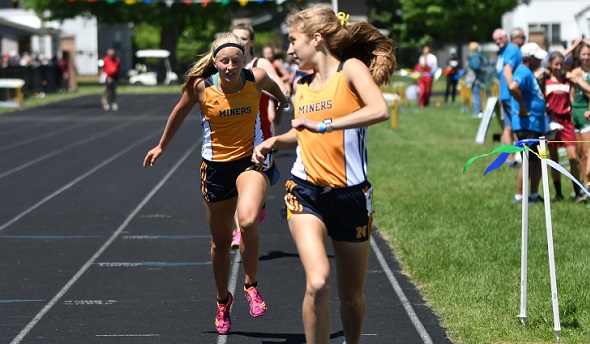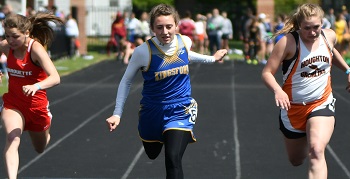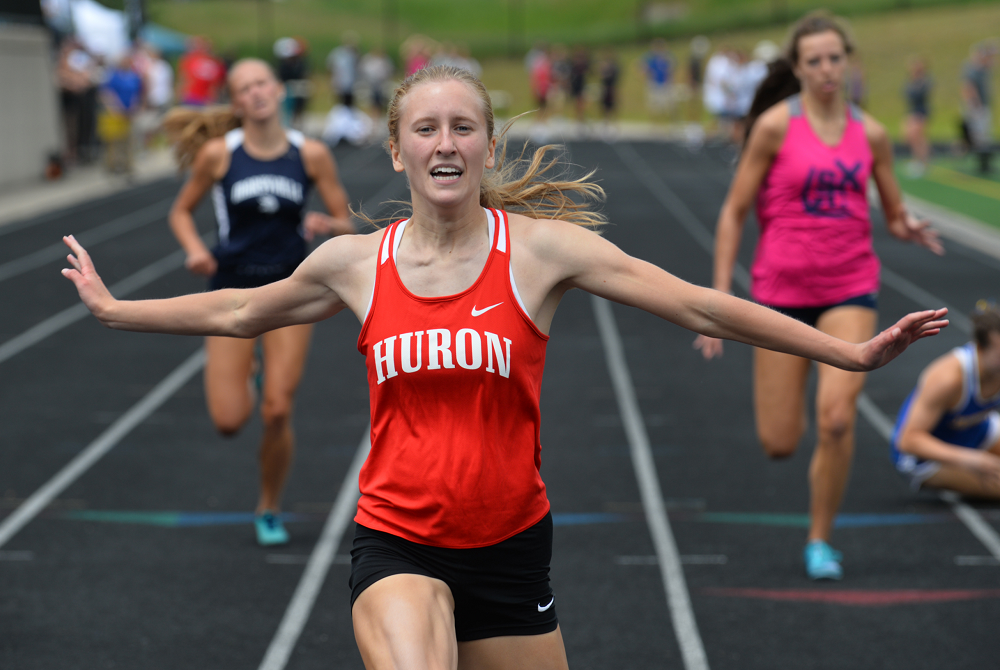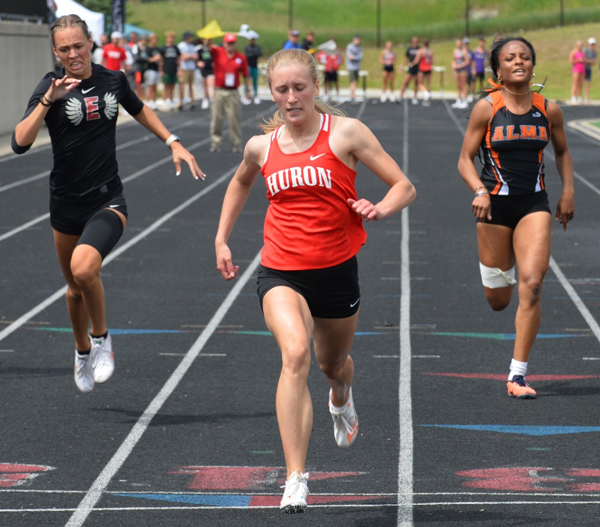
Speedy Pair Help Negaunee Pass Rival
By
John Vrancic
Special for MHSAA.com
June 2, 2018
KINGSFORD — Sophomore Emily Paupore and senior Clara Johnson provided the Negaunee girls with a potent 1-2 punch in the distance races Saturday, helping them earn their first Upper Peninsula Division 1 track title in eight years with 115 points.
With the win, the Miners also broke the seven-season championship streak for Marquette, which came in second this time with 89½ points. Kingsford was third with 84.
“This was a very exciting day,” said Negaunee coach Vickie Paupore. “At the beginning of the season we knew this was a special group of girls, and our seniors were excellent leaders and role models. They fought real hard. It was exciting to see Emily and Clara go 1-2 those races. It’s so inspiring to see the way they care about each other.”
Emily Paupore and Johnson helped the Miners open with a victory in the 3,200-meter relay in 10 minutes, 4.56 seconds. Paupore then captured the 800 (2:23.7), 1,600 (5:15.23) and set the U.P. meet record in the 3,200 (11:25.52), shaving 86 hundredths of a second off the previous record by Marquette’s Lindsey Rudden (11:26.38) in 2013.
“I’ll take anything if it’s a U.P. record,” said Emily, who also owns the school record in the 3,200 (11:11). “Being my fourth race, I knew it’d be tough.
“The past two years I’ve had so much support from Clara. It’s really sad to see she’s going.
“I always get butterflies before a race, which probably helped me in the 800. You can always build off that energy. I’m going to keep myself busy this summer with weight training and local road races to get ready for cross country. I love cross country. That’s my favorite.”
Johnson, who plans to play basketball at Michigan Tech next winter, was runner-up in the 800 (2:24.44), 1,600 (5:16.7) and 3,200 (12:01), all in personal-best times.
 “It was nice having somebody to train with the last two years,” said Johnson, who like Paupore was nearly overcome with emotion after their last high school race together. “There was a lot of pressure being the second seed because I knew there would be a lot of people coming after me. I did what I had to do to get second. I PRd, which is what you hope to do at the Finals, especially with this being my last one. In my junior year, I led Emily and pushed her to get better. This year she led and pushed me to get better.”
“It was nice having somebody to train with the last two years,” said Johnson, who like Paupore was nearly overcome with emotion after their last high school race together. “There was a lot of pressure being the second seed because I knew there would be a lot of people coming after me. I did what I had to do to get second. I PRd, which is what you hope to do at the Finals, especially with this being my last one. In my junior year, I led Emily and pushed her to get better. This year she led and pushed me to get better.”
Sophomore Chloe Norman, also part of the winning 3,200 relay, added a first in the 300 hurdles (47.78), second in high jump (4-8) and third in long jump (15-2½).
“Last year we set our school record in the 3,200 relay (9:46.91),” said Norman. “This time we just wanted to get a good place and conserve energy for other events.”
Marquette’s Rachel Hunt won long jump (15-2½), edging Houghton junior Anabel Needham by a half-inch. Hunt also helped the winning 800 relay (1:49.2) and was runner-up in the 200 (27.35).
Kingsford junior Olivia Allen took the 100 (13.09), retained her 200 (27.07) and 400 (59.51) titles and helped the Flivvers repeat as 1,600-meter relay champions (4:19).
“I’ve been working pretty hard on my starts, and I think I had one of my best starts in the 100,” said Allen. “It wasn’t perfect, but it gives me something to work on for next year.
“We had a great bunch of seniors who helped us so much. The weather was definitely on our side today. The breeze helped cool us off a little on the back stretch.”
PHOTOS: (Top) Negaunee’s Emily Paupore checks to make sure teammate Clara Johnson will finish second to her in a race Saturday; they came in first and second, respectively, in three events. (Middle) Kingsford’s Olivia Allen breaks across the line first in the 100-meter dash. (Photos by Cara Kamps. Click for more at RunMichigan.com.)

Multi-Sprint Champ Racing to Finish Huron Career Ahead of the Rest Again
By
Keith Dunlap
Special for MHSAA.com
May 25, 2023
NEW BOSTON – If there was one thing Elizabeth Anderson took pride in elementary school, it was simply showing that she could outrun everyone in sight.
 In fact, Anderson has an explanation for all the success she had in those playground races.
In fact, Anderson has an explanation for all the success she had in those playground races.
“Dominance when you are in elementary school,” Anderson quipped. “I don’t think I ever had a nickname. I just think everyone knew I was fast.”
Years later, pretty much everyone who follows track & field in the state of Michigan can attest to that.
A senior for New Boston Huron, Anderson has been faster than most other competitors in the state during her three-year high school career (with her freshman season in 2020 canceled due to COVID-19).
Last year, Anderson won titles at the Lower Peninsula Division 2 Finals in the 200-meter (25.07) and 400-meter (56.28) dashes, and was runner-up in the 100-meter dash (12.23).
Often, top sprinters focus on one or two of those three races. But Anderson is certainly a different breed of sprinter because she does all three.
In fact, she holds school records in all three of those events, and if all that weren’t enough, Anderson is a part of all three sprint relay teams.
“It is hard to give her events off,” said New Boston Huron head girls track coach Danielle Lobato.
Despite the different styles the 100, 200 and 400-meter dashes present, Anderson said there usually isn’t much adjusting when she goes from one of those races to another.
 The strategy is simply, “Let’s beat the other girls to the finish line.”
The strategy is simply, “Let’s beat the other girls to the finish line.”
“I don’t really go into each race changing up how I would run,” she said.
While enjoying and succeeding in all three races, Anderson said she actually does have a favorite among them.
“I would say the 400 is probably my favorite,” she said. “Even though it hurts, it’s satisfying to see how much you can get your time down in the 400 compared to any other race.”
Anderson said she started running track in sixth grade, but really got serious about it during the summer after her sophomore season, when she was invited to run for a local club.
Eventually, that led to her competing over the winter in indoor events.
She lived and breathed track so much that last fall, she decided to not run cross country so she could focus on a weightlifting regimen aimed at developing more leg strength.
“Once I started doing summer track, I realized I wanted to be doing this all the time,” she said.
Lobato said oftentimes in practice, Anderson is a de facto coach, given there is no better person she can think of for the younger runners on the team to learn from.
“I can’t always demonstrate these things I’m trying to teach,” she said. “You get to see it in real life (from Anderson), not in a YouTube video.”
After winning the 100, 200 and 400-meter dashes at her Regional meet last week, Anderson has her sights set on achieving the same trifecta of titles at next Saturday’s Finals in Grand Rapids.
Anderson has signed to run track at Michigan State, but has been plenty motivated to keep producing this spring in her final high school season.
“I’m really looking to defend my titles,” she said. “That is what is really motivating me to keep going. I want to keep in shape for the college season. I don’t want to lose any of the progress I have made. Ultimately, I just love running track.”
And since elementary school, Anderson has loved — and succeeded in — outrunning everyone else to the finish line.
“We knew we were getting something special,” Lobato said of when Anderson arrived in high school. “But you never expect this. All that she has accomplished is amazing.”
 Keith Dunlap has served in Detroit-area sports media for more than two decades, including as a sportswriter at the Oakland Press from 2001-16 primarily covering high school sports but also college and professional teams. His bylines also have appeared in USA Today, the Washington Post, the Detroit Free Press, the Houston Chronicle and the Boston Globe. He served as the administrator for the Oakland Activities Association’s website from 2017-2020. Contact him at [email protected] with story ideas for Oakland, Macomb and Wayne counties
Keith Dunlap has served in Detroit-area sports media for more than two decades, including as a sportswriter at the Oakland Press from 2001-16 primarily covering high school sports but also college and professional teams. His bylines also have appeared in USA Today, the Washington Post, the Detroit Free Press, the Houston Chronicle and the Boston Globe. He served as the administrator for the Oakland Activities Association’s website from 2017-2020. Contact him at [email protected] with story ideas for Oakland, Macomb and Wayne counties
PHOTOS (Top) New Boston Huron's Elizabeth Anderson clears the finish line during last season's LPD2 400 race. (Middle) Anderson, middle, outpaces the field to also win the 200. (Click for more from RunMichigan.com.)

